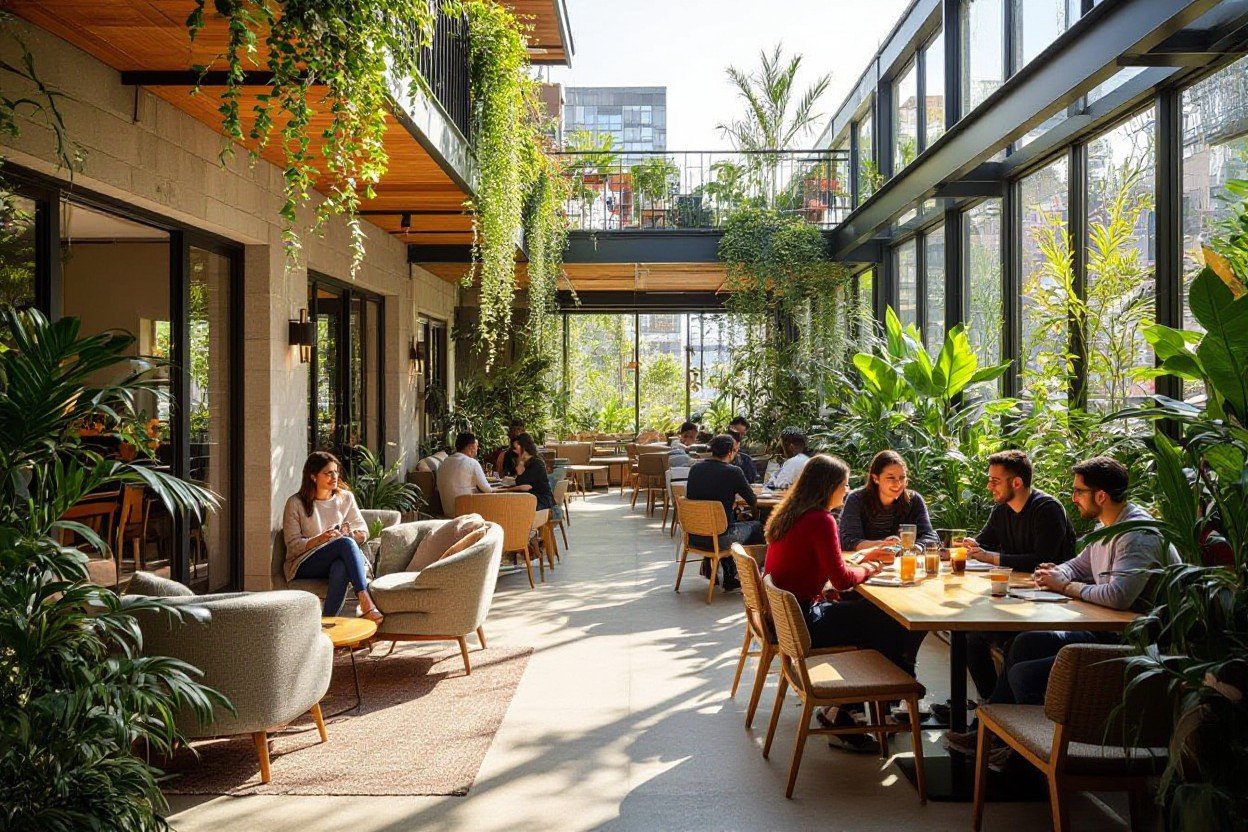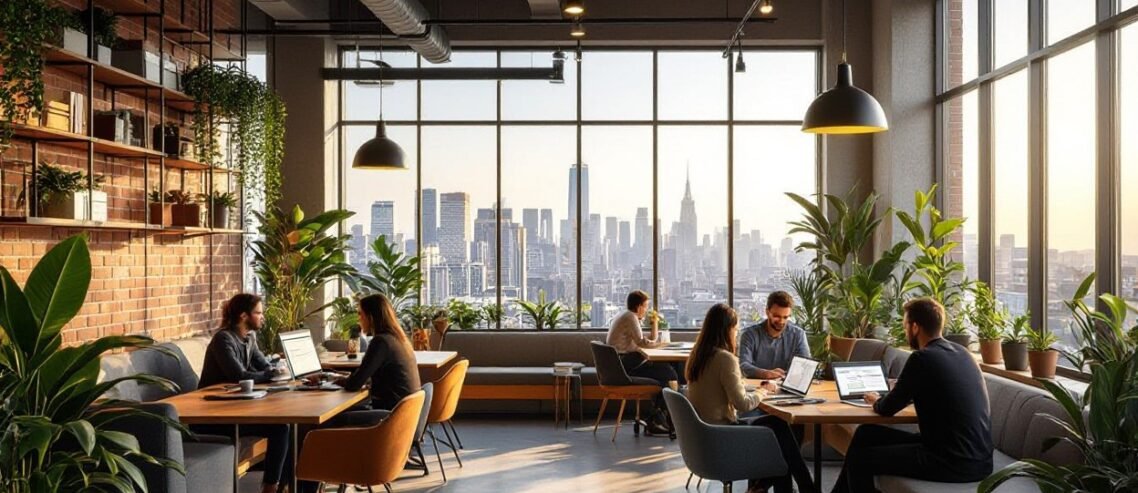Digital Nomads Co‑Living & Co‑Working Redefined
Most digital nomads seek more than just a place to work—they want a lifestyle that blends productivity, community, and wellness. As you explore today’s purpose-built co-living and co-working hubs, you’ll find spaces designed with sustainable materials, fast and reliable internet, and professional amenities tailored to your needs. While these hubs offer incredible opportunities to connect and grow, be aware that overcrowded or poorly managed spaces can hamper your focus and wellbeing. Understanding these evolving environments will help you choose the ideal spot to thrive professionally and personally on your journey.
Key Takeaways:
- Purpose-built co-living and co-working hubs are designed to foster community, prioritize wellness, and incorporate sustainable design principles.
- These spaces are equipped with fast, reliable internet and professional amenities to support productivity and connectivity for digital nomads.
- The integration of living and working environments creates a seamless experience that balances professional needs with lifestyle preferences.
The Evolution of Remote Workspaces
Remote workspaces have undergone a significant transformation, evolving far beyond the confines of the traditional office cubicle. The rise of purpose-built co-living and co-working hubs reflects a broader shift towards environments that nurture not just productivity, but also your well-being and sense of community. These spaces have integrated sustainable design principles and wellness features, recognizing the interconnectedness of work, lifestyle, and environment. Fast, reliable internet and professional-grade amenities have become baseline expectations, allowing you to maintain seamless connectivity and efficiency anywhere.
Instead of isolated desks or home offices, these new hubs foster collaboration and social interaction, helping to combat the isolation often associated with remote work. They serve as dynamic ecosystems where you can network, share ideas, and recharge collectively. By prioritizing community and sustainability alongside top-tier infrastructure, these workspaces redefine what it means to be productive in today’s digital age.
Historical Context: From Traditional Offices to Digital Nomadism
Work environments once centered on fixed locations, with traditional offices designed to accommodate large teams within structured schedules. The 20th century’s office models focused heavily on hierarchy and physical presence, often limiting flexibility. However, the dawn of the internet and mobile technologies gradually loosened these constraints, enabling early forms of telecommuting and freelance work. The shift accelerated dramatically during global disruptions such as the COVID-19 pandemic, when companies adapted to remote operations at scale.
Digital nomadism emerged as a lifestyle choice that took this freedom further—your office could become anywhere with an internet connection. Cities like Bali, Lisbon, and Chiang Mai became hotspots for nomads seeking environments that combined work with travel and cultural immersion. This evolution highlighted gaps in traditional workspaces, pushing the demand for co-living and co-working concepts tailored to nomads who value flexibility, community, and wellbeing above all else.
The Role of Technology in Shaping Remote Work Cultures
Technology has been the cornerstone driving the rapid evolution of remote work cultures, enabling you to stay connected and collaborate in unprecedented ways. Advances in high-speed internet, cloud computing, and collaboration platforms like Slack, Zoom, and Notion have become indispensable, with Zoom usage jumping by over 30 times during 2020 alone. These tools allow teams dispersed across continents to synchronize efforts, share real-time feedback, and maintain productivity without physical proximity.
Beyond communication software, technology has influenced workspace design itself. Smart office features such as automated lighting, ergonomic furniture, and IoT-enabled climate control are increasingly standard in co-working hubs, offering you a more comfortable, adaptive work environment. Integrations that manage booking systems and community events further elevate these spaces, transforming them into multifunctional environments that respond directly to your needs and preferences.
With constant improvements in 5G networks and cloud infrastructure, you can expect even greater mobility and speed in your work processes. Virtual Reality (VR) and Augmented Reality (AR) tools are poised to add new dimensions to remote collaboration, simulating presence and physical interaction in ways previously unimaginable. This technological trajectory ensures that your workspace remains flexible, immersive, and truly global.

Crafting the Ideal Co-Living Experience
You’ll find that the best co-living spaces are designed with intentionality, prioritizing both social interaction and personal comfort. Spaces blend private quarters with expansive communal areas that invite spontaneous collaboration and conversation. Think modular layouts that allow flexible usage—from quiet nooks for focused work to open lounges that encourage connection among residents. Lighting, acoustics, and air quality are optimized to enhance your productivity and mood throughout the day. Fast, reliable internet is a non-negotiable, supporting seamless virtual meetings or creative brainstorming sessions without interruption.
The integration of sustainable materials and energy-efficient technologies often defines these hubs, minimizing environmental impact while fostering a sense of shared responsibility among residents. You’ll notice features such as reclaimed wood furnishings, low-VOC paints, and solar-paneled rooftops that contribute not just to sustainability but to the overall ambiance and well-being of the community. These details shape a living environment that feels both modern and mindful, aligning with your values and lifestyle as a digital nomad.
Design Principles for Community and Collaboration
Spaces crafted for collaboration leverage open-plan work areas alongside strategically placed private rooms, offering you the choice between interaction and solitude. Communal kitchens, rooftop terraces, and game rooms become natural gathering points where ideas spark and relationships deepen. The use of biophilic design elements—such as indoor plants and natural light—breaks down barriers, fostering creativity and reducing stress. Furniture arrangements encourage face-to-face engagement, while writable walls and interactive displays turn shared spaces into dynamic hubs for brainstorming.
Acoustic zoning plays a vital role, allowing lively group discussions without disturbing those needing focus. You’ll benefit from sound-absorbing panels, designated quiet zones, and sound masking technologies that balance energy and concentration levels perfectly. These carefully curated environments help you transition smoothly between collaborative sessions and deep work, elevating both your output and your social experience.
Wellness-Centric Amenities: Balancing Work and Well-being
Efficient co-living hubs include wellness-focused amenities that support your physical, mental, and emotional health. On-site fitness studios, meditation rooms, and outdoor green spaces invite regular movement and relaxation, combating the sedentary nature of digital work. Nutritionally mindful kitchens stocked with organic and locally sourced ingredients encourage healthier eating habits. You’ll also find wellness workshops focusing on mindfulness, ergonomics, and stress management—designed to help you sustain energy and focus throughout the workday.
Sleep pods or quiet rest areas prioritize restorative breaks, recognizing that your productivity depends on quality downtime. Some hubs even incorporate advanced air purification systems to maintain high indoor air quality, which studies link directly to improved cognitive function and mood stabilization. These amenities deliver a holistic approach to well-being, seamlessly integrating into your daily schedule and enhancing your overall quality of life in a co-living setting.
To examine deeper, spaces like Selina’s flagship hubs showcase how wellness-centered design can transform your routine: gyms with views, onsite therapists, and biweekly yoga classes create natural rhythms of self-care. Incorporating scalable health tech such as circadian lighting systems offers another layer of thoughtful support, adjusting your environment to your natural biological cycles. These features don’t just add luxury—they provide tangible benefits that empower you to sustain productivity without compromising well-being.

The Economics of Co-Living and Co-Working
Analyzing Cost Structures: Affordability vs. Value
The balance between affordability and value emerges as a defining factor in today’s purpose-built co-living and co-working hubs. You’ll notice that these spaces often command a premium compared to traditional rentals, with monthly fees ranging from $700 to over $1,500 depending on location and amenities. However, this price reflects more than just a roof or desk; it includes access to wellness programs, community events, sustainable infrastructure, and professional-grade internet that can cost you hundreds separately. For digital nomads mindful of both budgets and experience, the embedded value in these hubs often outstrips isolated alternatives.
Beyond immediate expenses, you benefit from bundled services reducing your overall cost of living and working. Shared utilities, cleaning, and networking opportunities help dilute expenses that typically arise in a remote or freelance lifestyle. Many hubs use flexible membership models, offering everything from daily passes to longer-term leases, enabling you to scale costs in alignment with your project timelines and income streams. That flexibility allows you to optimize your spending while maximizing your productivity and social engagement.
Revenue Models: Sustaining Purpose-Built Hubs
Diversified revenue streams form a backbone for the sustainability of co-living and co-working hubs. Membership fees are the primary source, yet many operators innovate by leasing event spaces for conferences or workshops, tapping into corporate partnerships, and offering premium add-ons such as private rooms, specialized equipment, or wellness services. For example, a hub in Lisbon generates nearly 40% of its revenue from corporate events and strategic partnerships, supplementing its member subscriptions.
Many hubs also embrace a tiered pricing strategy, differentiating access based on workspace options, contract lengths, and included amenities. This approach not only attracts a broader audience—ranging from transient digital nomads to longer-term remote workers—but also allows hubs to maximize revenue without alienating cost-conscious users. By combining community-focused programming with a strong operational backbone, these hubs remain financially viable while promoting sustainable lifestyles and collaboration.
Expanding into retail offerings and branded merchandise presents an additional revenue avenue, reinforcing community identity while generating profit. Some hubs integrate local artisan products or eco-friendly goods into their spaces, offering residents exclusive discounts or memberships with local services. This creates a symbiotic economic ecosystem where the hub, its members, and the surrounding neighborhood thrive together, making your investment in these spaces not just about a place to stay or work, but a gateway to a sustainable and economically vibrant community.

The Social Fabric of Co-Living Communities
Purpose-built co-living hubs are redefining how you connect with others by creating environments that nurture meaningful relationships. These spaces often incorporate communal kitchens, wellness areas, and shared lounges designed to spark casual conversations and group activities. The integration of sustainable design not only supports environmental responsibility but also fosters a sense of shared purpose among residents, making your daily interactions more than casual exchanges—they become part of a collective lifestyle centered on well-being and community.
Fast, reliable internet and professional amenities are not just conveniences here; they enable seamless collaboration and social engagement both online and offline. Expect community managers to facilitate regular events like skill-sharing workshops, wellness sessions, and cultural meetups that align with your interests and work rhythms. These elements work together to build a genuine social fabric that supports both personal growth and professional networking.
Fostering Connections: Strategies to Enhance Community Engagement
Community engagement in these co-living settings thrives through thoughtfully curated experiences that encourage authentic interaction. You may find monthly potlucks, coworking challenges, or group volunteering projects, all designed to break the ice and deepen connections. Technologies like dedicated community apps also keep you informed and engaged by streamlining communication and coordinating activities tailored to your preferences.
Another strategy involves integrating wellness-focused programming, such as group yoga classes or meditation circles, which naturally bring residents together in a low-pressure environment. Beyond casual mingling, these activities strengthen mental and physical health while fostering a support system that extends far beyond your individual living space.
Networking Opportunities: Leveraging Co-Working Spaces for Growth
Co-working hubs within co-living environments offer more than just desks and Wi-Fi—they become catalysts for your professional growth. You can tap into a dynamic ecosystem where startups, freelancers, and remote employees converge, creating fertile ground for collaboration and innovation. Regular pitch nights, workshops led by industry experts, and mastermind groups provide opportunities to showcase your work, gain feedback, and form strategic partnerships.
Designed with sustainability in mind, these workspaces also focus on wellness amenities like ergonomic furniture, standing desks, and biophilic design elements that enhance productivity while reducing stress. Such environments not only elevate your daily work experience but embed you in an active professional community that encourages learning and advancement.
Examples like the Rise Co-Living and Co-Working hubs emphasize this blend of community and careers by hosting quarterly networking events that connect residents with venture capitalists and seasoned entrepreneurs. Engaging in these curated interactions allows you to expand your professional circle organically, turning your living space into a launchpad for new business opportunities.
Sustainability and Future Trends in Co-Living
The newest wave of co-living spaces isn’t just about shared amenities and affordability; sustainability has become a defining feature guiding design and operation. You’ll find buildings incorporating renewable energy sources such as solar panels and green roofs, dramatically reducing their carbon footprint while promoting a healthier environment for residents. Many hubs are designed to maximize natural light and ventilation, cutting down on energy consumption and improving indoor air quality, which directly benefits your well-being and productivity. Integrating waste management systems that encourage composting and recycling further aligns your living space with responsible environmental practices.
Looking ahead, the convergence of digital connectivity with sustainable infrastructure creates a synergy that redefines how you work and live. Smart technology embedded in co-living and co-working hubs monitors energy use in real-time, enabling you to participate in energy-saving behaviors consciously. Moreover, community-driven sustainability initiatives, from urban gardening to collective transportation arrangements like bike-sharing programs, add layers of environmental engagement that build more resilient, connected neighborhoods. These trends illustrate a future where your living and working environments evolve responsively to ecological and social needs.
Eco-Friendly Designs and Practices in Workspaces
Workspaces now go beyond aesthetics, embedding eco-friendly materials like reclaimed wood, low-VOC paints, and recycled metals into their core structures. These choices reduce environmental impact and create healthier interiors free from harmful chemicals that can affect your focus and energy levels. Efficient LED lighting systems paired with occupancy sensors ensure that electricity is only used when necessary, lowering energy costs and carbon emissions without compromising on the quality of your professional environment.
Many hubs actively incorporate biophilic design elements such as living walls and indoor plants, which not only enhance air quality but also improve cognitive function and reduce stress. Such features create a tangible connection with nature, vital for digital nomads who often find themselves indoors for extended hours. You’ll also notice workspace layouts promoting flexibility and collaboration through moveable furniture and open-plan zones, optimized not just for productivity but for sustainable resource use and comfort.
The Future of Urban Living: Predictions for the Next Decade
By 2034, urban co-living is expected to become increasingly modular and technology-integrated, enabling rapid customization of spaces according to your lifestyle and work demands. Developments will likely embrace a mixed-use model, blending residential, professional, wellness, and social areas seamlessly. This holistic approach means your home could double as a workspace and community hub, equipped with AI-driven environmental controls that tailor temperature, lighting, and acoustics to your personal preferences and sustainability goals.
Networks of co-living hubs will connect across cities globally, giving you access to a consistent living and working standard wherever you go. Expect advancements in sustainable transportation links, including electric vehicle charging stations and autonomous shuttles dedicated to co-living communities. These integrated systems will enhance your mobility while minimizing environmental impact, supporting a lifestyle that values convenience without sacrificing eco-consciousness.
Additionally, innovations in circular economy principles will characterize future co-living setups, where you participate actively in resource-sharing programs and on-site upcycling initiatives. These models not only reduce waste but foster a stronger sense of community ownership, making sustainable urban living a participatory experience rather than a mere benefit.
Final Thoughts on the Future of Digital Nomad Spaces
The Increasing Demand for Integrated Experiences
You’re seeing a clear shift toward spaces that do more than just provide a desk and Wi-Fi. Communities designed around wellness and sustainability have become key differentiators. For example, hubs like The Collective in London and Roam in Bali incorporate green building materials and daily mindfulness sessions, pushing the boundaries of what a work‑and‑live environment can offer. In fact, industry data shows that co-living and co-working providers focusing on holistic lifestyles report up to 30% higher occupancy rates compared to traditional setups.
Technology and Amenities Driving Productivity
Fast, reliable internet is only the baseline now. You’ll find purpose-built hubs equipped with cutting-edge tech—think dedicated fiber connections, digital conference rooms, and plug-and-play professional studios—that empower you to collaborate effortlessly across time zones. This infrastructure supports a diverse range of professions, from remote developers to digital artists, making these spaces true productivity ecosystems. As the market evolves, those who prioritize well-rounded amenities aligned with your work and wellness needs will dominate the landscape.
FAQ
Q: What features make purpose-built co-living and co-working spaces ideal for digital nomads?
A: These spaces are designed to foster a sense of community while supporting productivity and well-being. They often include sustainable architecture and wellness-focused amenities such as fitness areas, green spaces, and mindfulness rooms. High-speed, reliable internet and professional-grade workspaces ensure digital nomads can work efficiently. Additionally, social events and networking opportunities help build connections among residents.
Q: How do sustainable design elements enhance the experience in co-living and co-working hubs?
A: Sustainable design prioritizes environmental responsibility and occupant health, making co-living and co-working hubs more enjoyable and eco-friendly. Natural lighting, energy-efficient appliances, use of recycled materials, and biophilic design elements create comfortable and inspiring environments. These features reduce the ecological footprint of the space while promoting a healthier lifestyle for users, aligning with many digital nomads’ values.
Q: In what ways do professional amenities improve productivity for residents in these hubs?
A: Professional amenities such as soundproof meeting rooms, ergonomic furniture, printing facilities, and dedicated office equipment create an efficient work environment. Access to these resources eliminates common work-from-home distractions and technical limitations. Furthermore, fast and reliable internet connectivity supports seamless virtual collaboration, making these hubs an excellent choice for digital nomads managing remote projects or clients.


Comments
Leave a Comment